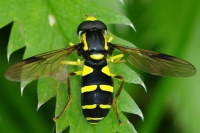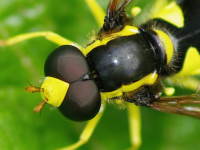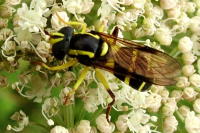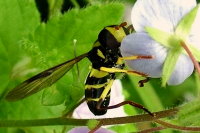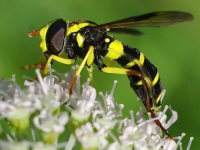Phylum Arthropoda (Arthropods) ➔ Subphylum Hexapoda (Hexapods) ➔ Class Insecta (Insects) ➔ Order Diptera (True flies) ➔ Family Syrphidae (Hoverflies)
Xanthogramma pedissequum (Harris, 1776)
Späte Gelbrandschwebfliege
Synonyms and other combinations:
Doros decoratus Zetterstedt, 1843 | Scaeva flavicincta Gravenhorst, 1807 | Syrphus ornatus Meigen, 1822 | Syrphus pulcher Meigen, 1835 | Xanthogramma bilobatum Szilady, 1940 | Xanthogramma flavifrons Szilady, 1940 | Xanthogramma flavipleura Coe, 1957 | Xanthogramma nigripes Szilady, 1940 | Xanthogramma nobilitatum Frey, 1946 |
Classification:
Xanthogramma pedissequum belongs to the subfamily Syrphinae, tribe Syrphini.Distribution:
Palaearctic: From Western Europe to Western Siberia; in Europe from southern Scandinavia to the Mediterranean and from Ireland to Russia.Habitat:
Grassland with very different vegetation heights, gardens and parks, open areas along streams in thermophilous Quercus and mesophilous Fagus forest.Description:
Body length 10 - 12 mm; eyes bald; thorax with yellow side stripes; abdomen oval, with 3 pairs of yellow spots on tergits 2 - 4; wide triangular spots on tergit 2; legs orange/yellow; hind femora and tibia with dark rings.Similar species:
The similar looking Xanthogramma citrofasciatum has narrow yellow spots on the 2nd tergit.Biology:
Xanthogramma pedissequum flies with a peak in July from May to September. Adults visit the flowers of umbelliferae, yellow compositae, euphorbia, hawthorn, elderberry and other plants from different families. The males hover in 1 - 3 m height between and close above the vegetation.Larvae of Xanthogramma pedissequum were found in the nests of the Yellow Meadow Ant Lasius flavus and the Black Garden Ant Lasius niger. They are active in particular at night and feed on various species of root aphids, which are herded by the ants.
References, further reading, links:
- Pape T. & Thompson F.C. (eds) (2017). Systema Dipterorum (version 2.0, Jan 2011). In: Species 2000 & ITIS Catalogue of Life, 2017 Annual Checklist (Roskov Y., Abucay L., Orrell T., Nicolson D., Bailly N., Kirk P.M., Bourgoin T., DeWalt R.E., Decock W., De Wever A., Nieukerken E. van, Zarucchi J., Penev L., eds.). Digital resource at www.catalogueoflife.org/annual-checklist/2017. Species 2000: Naturalis, Leiden, the Netherlands. ISSN 2405-884X.
- Gerald Bothe: Bestimmungsschlüssel für die Schwebfliegen (Diptera, Syrphidae) Deutschlands und der Niederlande, DJN, 1984, ISBN 3-923376-07-3
- M.C.D.Speight: Species Accounts of European Syrphidae (Diptera), Glasgow 2011, Syrph the Net, the database of European Syrphidae, vol. 65, 285 pp., Syrph the Net publications, Dublin.
- Menno Reemer, Willem Renema, Wouter van Steenis, Theo Zeegers, Aat Barendregt, John T. Smit, Mark P. van Veen, Jeroen van Steenis, Laurens van der Leij: De Nederlandse Zweefvliegen (Diptera: Syrphidae), Nederlandse Fauna 8, 2009.
- Speight, M.C.D. & Sarthou, J.-P. (2014) StN keys for the identification of the European species of various genera of Syrphidae (Diptera) 2014 / Clés StN pour la détermination des espèces Européennes de plusieurs genres des Syrphidae (Diptères) 2014. Syrph the Net, the database of European Syrphidae, Vol. 80, 125 pp, Syrph the Net publications, Dublin
- Anasimyia interpuncta
- Anasimyia transfuga
- Baccha elongata
- Blera fallax
- Brachyopa sp.
- Brachypalpoides lentus
- Brachypalpus laphriformis
- Brachypalpus sp.
- Brachypalpus valgus
- Ceriana conopsoides
- Ceriana vespiformis
- Chalcosyrphus femoratus
- Chalcosyrphus nemorum
- Chalcosyrphus valgus
- Cheilosia albipila
- Cheilosia albitarsis
- Cheilosia chrysocoma
- Cheilosia illustrata
- Cheilosia pagana
- Cheilosia scutellata
- Cheilosia sp.
- Cheilosia variabilis
- Chrysogaster sp.
- Chrysotoxum bicinctum
- Chrysotoxum fasciatum
- Chrysotoxum festivum
- Chrysotoxum verralli
- Criorhina berberina
- Dasysyrphus albostriatus
- Dasysyrphus sp.
- Dasysyrphus tricinctus
- Didea fasciata
- Didea intermedia
- Didea sp.
- Epistrophe diaphana
- Epistrophe eligans
- Epistrophe flava
- Epistrophe grossulariae
- Epistrophe melanostoma
- Epistrophe melanostoma/nitidicollis
- Epistrophella euchroma
- Episyrphus balteatus
- Eristalinus aeneus
- Eristalinus megacephalus
- Eristalinus taeniops
- Eristalis arbustorum
- Eristalis interrupta
- Eristalis intricaria
- Eristalis lineata
- Eristalis pertinax
- Eristalis rupium
- Eristalis similis
- Eristalis sp.
- Eristalis tenax
- Eumerus purpurariae
- Eumerus sp.
- Eupeodes corollae
- Eupeodes luniger
- Eupeodes sp.
- Eurimyia lineata
- Ferdinandea cuprea
- Hammerschmidtia ferruginea
- Helophilus hybridus
- Helophilus pendulus
- Helophilus sp.
- Helophilus trivittatus
- Ischiodon aegyptius
- Leucozona glaucia
- Leucozona laternaria
- Leucozona lucorum
- Melangyna lasiophthalma
- Melangyna quadrimaculata
- Melangyna umbellatarum
- Melanogaster sp.
- Melanostoma scalare
- Meligramma triangulifera
- Meliscaeva cinctella
- Merodon ambiguus
- Merodon avidus
- Merodon equestris
- Merodon moenium
- Merodon obscuritarsis
- Merodon sp.
- Microdon analis/major
- Microdon mutabilis/myrmicae
- Myathropa florea
- Myolepta dubia
- Orthonevra sp.
- Paragus sp.
- Parasyrphus lineolus
- Parhelophilus sp.
- Pipiza austriaca
- Pipiza bimaculata
- Pipiza fenestrata
- Pipiza quadrimaculata
- Pipiza sp.
- Platycheirus rosarum
- Platycheirus sp.
- Rhingia campestris
- Rhingia rostrata
- Scaeva albomaculata
- Scaeva pyrastri
- Scaeva selenitica
- Sericomyia lappona
- Sericomyia silentis
- Sphaerophoria rueppelli
- Sphaerophoria scripta
- Sphaerophoria sp.
- Sphegina sp.
- Spilomyia saltuum
- Syritta pipiens
- Syrphus ribesii
- Syrphus sp.
- Syrphus vitripennis
- Temnostoma bombylans
- Temnostoma meridionale
- Temnostoma vespiforme
- Tropidia scita
- Volucella bombylans
- Volucella inanis
- Volucella pellucens
- Volucella zonaria
- Xanthogramma citrofasciatum
- Xanthogramma pedissequum
- Xylota segnis
- Xylota sp.
- Xylota sylvarum
